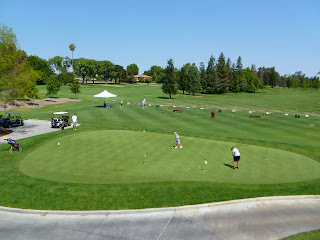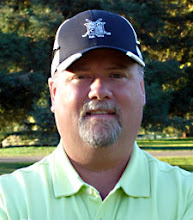Tuesday, August 17, 2010
Green Report-Consistency
Every Green Committee meeting, I update the members with the current condition of the greens. Our highest priority at the club is the greens and most would agree that a good putting surface is the centerpiece of a great course. So I will begin to write regular updates on green conditions to the blog to keep readers informed.
Consistency of greens from the putting green, to number 1, to number 18 should be pretty close in speed, firmness, and condition. That is a goal here that we have yet to achieve, but we keep working towards year after year. The problems we are working to correct involve different turf species, different soils, and varying levels of thatch. Our maintenance practices are specifically tailored toward each green's specific needs.
To start with, the practice putting green is a massive headache which throbs year round without rest. I think most superintendents would agree that their practice greens are some of the most difficult to manage. Our main problem is limited space, and like a family in a studio apartment, this green is less than 3000 square feet. Tournaments with over 100 people mark up this green quickly and a putting contest, with two hundred feet wiggling into alignment in the same spot will result in two yellow foot prints in the morning.
To speed up construction and open sooner, the green was sodded and we are still trying to encourage roots to move past the sod layer. The turf species of the putting green is Dominant Plus bentgrass, which is the same as the 1st green. I am not overly thrilled with this variety in this climate because it shuts down in winter and is not very competitive against poa annua.
Both the putting green and the first green have little poa, so we are treating them with a growth regulator that gives bentgrass a competitive advantage. Last winter, we used this product on all the greens with great success and will continue that practice starting in October. For now, only the putting green and #1 will receive this treatment because the other greens have much more annual bluegrass and it's way too risky to try this time of year.
The growth regulators we use on the poa annua cause it to sink slightly and result in an uneven, sometimes bumpy green. The bentgrass can out-grow the sunken spot and get us closer to solid bentgrass greens. Patience. It takes some time.
So how's that for consistency? I've only mentioned two greens and they're already very different compared to the rest and they can play differently too. On that note, the first green is much firmer than any other green on the course because it has 9% silt in it's structural makeup. This has improved over the six years since construction, but changing the makeup of soil is extremely slow when aerification only takes out 5% of the surface at one time.
So that does it for the first Green Report and it gets the two odd-ball greens out of the way. Both have been healthy and growing well this year with no disease or major stress. Next time, I will share some of the other inconsistencies around the course on the other 17 greens and describe what we are doing to get the speed of each one as close to the next as we possibly can.
Consistency of greens from the putting green, to number 1, to number 18 should be pretty close in speed, firmness, and condition. That is a goal here that we have yet to achieve, but we keep working towards year after year. The problems we are working to correct involve different turf species, different soils, and varying levels of thatch. Our maintenance practices are specifically tailored toward each green's specific needs.
To start with, the practice putting green is a massive headache which throbs year round without rest. I think most superintendents would agree that their practice greens are some of the most difficult to manage. Our main problem is limited space, and like a family in a studio apartment, this green is less than 3000 square feet. Tournaments with over 100 people mark up this green quickly and a putting contest, with two hundred feet wiggling into alignment in the same spot will result in two yellow foot prints in the morning.
To speed up construction and open sooner, the green was sodded and we are still trying to encourage roots to move past the sod layer. The turf species of the putting green is Dominant Plus bentgrass, which is the same as the 1st green. I am not overly thrilled with this variety in this climate because it shuts down in winter and is not very competitive against poa annua.
Both the putting green and the first green have little poa, so we are treating them with a growth regulator that gives bentgrass a competitive advantage. Last winter, we used this product on all the greens with great success and will continue that practice starting in October. For now, only the putting green and #1 will receive this treatment because the other greens have much more annual bluegrass and it's way too risky to try this time of year.
The growth regulators we use on the poa annua cause it to sink slightly and result in an uneven, sometimes bumpy green. The bentgrass can out-grow the sunken spot and get us closer to solid bentgrass greens. Patience. It takes some time.
So how's that for consistency? I've only mentioned two greens and they're already very different compared to the rest and they can play differently too. On that note, the first green is much firmer than any other green on the course because it has 9% silt in it's structural makeup. This has improved over the six years since construction, but changing the makeup of soil is extremely slow when aerification only takes out 5% of the surface at one time.
So that does it for the first Green Report and it gets the two odd-ball greens out of the way. Both have been healthy and growing well this year with no disease or major stress. Next time, I will share some of the other inconsistencies around the course on the other 17 greens and describe what we are doing to get the speed of each one as close to the next as we possibly can.
Subscribe to:
Post Comments (Atom)




0 comments:
Post a Comment